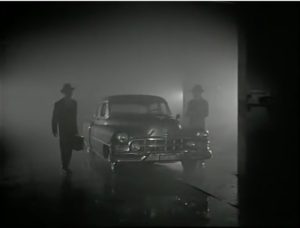The following excerpt appears in “Ten Shades of Noir” – ( for the entire article, follow the link below.)
Dark rooms with light slicing through venetian blinds, alleys cluttered with garbage, abandoned warehouses where dust hangs in the air, rain-slickened streets with water still running in the gutters, dark detective offices overlooking busy streets: this is the stuff of film noir–that most magnificent of film forms–a perfect blend of form and content, where the desperation and hopelessness of the situations is reflected in the visual style, which drenches the world in shadows and only occasional bursts of sunlight. Film noir, occasionally acerbic, usually cynical, and often enthralling, gave us characters trying to elude some mysterious past that continues to haunt them, hunting them down with a fatalism that taunts and teases before delivering the final, definitive blow.
Unlike other forms of cinema, the film noir has no paraphernalia that it can truly call its own. Unlike the western, with cattle drives, lonely towns on the prairie, homesteading farmers, Winchester rifles, and Colt 45s, the film noir borrows its paraphernalia from other forms, usually from the crime and detective genres, but often overlapping into thrillers, horror, and even science fiction (as in the great “what’s it” box from Kiss Me Deadly). The visual style echoes German expressionism, painting shafts of light that temporarily illuminate small chunks of an ominous and overbearing universe that limits a person’s chances to slim and none. For as Paul Schrader said in his influential “Notes on Film Noir” essay, “No character can speak authoritatively from a space which is continually being cut into ribbons of light.”
Heroes in the film noir world would forever struggle to survive. Some of the heroes learned to play by the rules of film noir and survived by exposing corruption, such as Humphrey Bogart in The Big Sleep and Dick Powell in Murder, My Sweet. But more often than not, they were the saps destroyed by love (Fred MacMurray in Double Indemnity and Edward G. Robinson in Scarlet Street), a past transgression (Robert Mitchum in Out of the Past), or overly ambitious goals (Richard Widmark in Night and the City and Sterling Hayden in The Killing).
Film noir first appeared in the early ’40s in movies such as Stranger on the Third Floor (often cited as the first full-fledged noir) and This Gun For Hire. While soldiers went to war, film noir exposed a darker side of life, balancing the optimism of Hollywood musicals and comedies by supplying seedy, two-bit criminals and doom-laden atmospheres. While Hollywood strove to help keep public morale high, film noir gave us a peek into the alleys and backrooms of a world filled with corruption. And film noir remained an important form in Hollywood until the late ’50s. Films such as Touch of Evil (1958) closed out the cycle. By then, the crime and detective genres were playing out their dramas in bright lights, with movies such as The Lineup containing noir elements but not the iconography of darkened streets and chiaroscuro lighting. (Post-’50s noirs such as Farewell, My Lovely and Body Heat are nostalgia first and noirs second.)
from “Ten Shades of Noir”, by Alain Silver http://www.imagesjournal.com/issue02/infocus.htm
